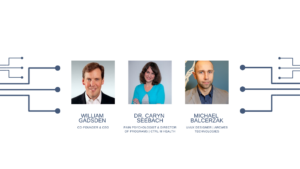In this episode of Product Hacker, Brian Glick, the CEO and founder of Chain.io. Chain.io a cloud platform that makes global supply chain management more affordable and simpler for businesses. Brian Glick will share his experience discovering Chain.io’s product strategy. What are Hub, Flow, and Vault and how do clients figure out which service offering is right for them?


Kurt Schiller [00:00:01]: Welcome to Product Hacker, the Arcweb Business Innovation Podcast, we bring you the latest from the world of business innovation, from emerging technologies to game-changing ideas. Product Hacker connects you with the people and concepts that are changing the face of business. I’m your host, Arcweb Head of Marketing, Kurt Schiller.
Kurt Schiller [00:00:20]: Arcweb will be a featured company at the Healthcare of Tomorrow event on October 23rd brought to you by the Greater Philadelphia Chamber of Commerce. Join us as we explore the digital transformation going on in the health care industry and talk about how it’s impacting patients. The event will feature Steven Klasko of Jefferson Health, as well as our own CEO, Chris Cera.
Kurt Schiller [00:00:42]: Welcome to Product Hacker brought to you by Arcweb Technologies. I’m your host, Kurt Schiller. Launching a new product is never easy. There’s a thousand things to consider at every step of the way. And it’s even tougher if you’ve previously been a company with just one product when the company and the product are, in effect, one and the same. Today, we’ll be talking with Brian Glick of Chain.io about navigating that transition. Over two decades and global logistics, Brian has helped major retail and apparel companies develop and integrate global supply chain management systems that span tens of thousands of vendors and partners across the globe. In 2017, Brian founded Chain.io, a cloud execution platform that helps medium and large enterprises integrate all the different systems components that it takes to keep a global supply chain moving. Connecting ocean carriers, customs brokers, retailers, truckers and warehouses, Chain.io helps coordinate the hundreds of systems that have to work behind the scenes for every ship and every day. Brian, thanks for being on the show.
Brian Glick [00:01:37]: Thanks for having me.
Kurt Schiller [00:01:38]: Could you talk us through Chain.io’s journey so far?
Brian Glick [00:01:41]: So we’re founded in 2017, but the journey really goes back probably 20 years before that. So I spent my whole career and most of my team has helping different companies in the supply chain and logistics talk to each other electronically, all these computers. And every single time we sat down to do it, it was like starting from scratch. So each time we wanted to have a warehouse connect to a shipping company, we started from the beginn and we realized over time that with what we can do in the cloud nowadays, it doesn’t make any sense to start over every single time. So instead we decided to build a company with a cloud platform that lets us build these reusable components so that the 50th time a company is connecting to a warehouse, they’re not starting over and acting like it’s the first time. Saves them a ton of time and a ton of money and really lets them be more agile.
Kurt Schiller [00:02:29]: So to date, you’ve really just had the one product, which is your platform. And I believe that that vault was the terminology that you use for that.
Brian Glick [00:02:37]: So when we started, we had Chain.io and it was the cloud platform. One of the things that we did over the last couple of years was, we realized there was an opportunity in the blockchain space for a thing that was sort of similar, but a little different. And that’s what we ended up calling Vault. What happened was we had our generic cloud platform, which had an API and we really just called it the Chain.io platform and we developed this other thing that was allowing companies to record data onto a blockchain and–.
Brian Glick [00:03:07]: We realized that was a little different. We had to give that a name, and that name became “Vault”. So that kind of happened by accident, which then created a huge problem for us because we had this thing that represents 5 or 10 percent of what we do that had a name and then the other 90 or 95 percent had no name and it made it very difficult for us to talk about what we do because people kind of anchored on Vault–
Kurt Schiller [00:03:38]: Just like I just did.
Brian Glick [00:03:39]: Yeah, just like you just did. Exactly. That was the problem. So that was exactly it.
Kurt Schiller [00:03:45]: I’m happy to be the example subject of just what the problem was. So now you’re kind of pivoting and growing where you’re going to be launching a pair of new products that kind of fit into the Chain.io family. Could you talk us through those?
Brian Glick [00:03:58]: Right. So we’re launching two products. One is called Flow. And one is called Hub. And what we did was we took the use cases that we’ve learned over the last couple of years of specifically how our clients were using our platform. And we realized they fell into two large categories.
Brian Glick[00:04:17]: One was people who want to move information really fast. So that became Flow. So these are things like collecting telemetry from trucks or Internet of Things sensors or status messages flowing between companies or fast-moving accounting records where you want to make sure all your systems are in sync.
Brian Glick[00:04:37]: And then there was this other set of use cases that was data that exists over kind of a longer period of time that you really wanted a central hub that lots of people can communicate with. So think about, like a purchase order that might be issued on day one. And there’s kind of a six month lifecycle of the manufacturing and the shipping and all of the things that happen with that order. So it becomes a reference document for a bunch of transactions. Our engineering team realized that those things had different architectures underneath them. And so the product marketing side of it started the conversation where the sales team said we need to be able to talk about these things.
Brian Glick[00:05:12]: And that actually opened up for the engineering team, kind of an understanding of our product the better that we really did need to go on to different engineering tracks. So I don’t know that the engineers want to admit this, but the sales team sort of architected their roadmap for them. Again, I might get smacked back at the office for saying that. But it was it was one of those nice kind of cohesive moments where we were able to follow the sales team and their conversations, which influence marketing, which in turn influence engineering.
Kurt Schiller [00:05:41]: Was there like a specific light bulb moment from the sales team when you’re like, oh, man, okayq. This this finally coalesced into this this decision.
Building a digital product?
Brian Glick [00:05:48]: There was a lot of complaining then piled up, to be honest. So, we have a weekly sales team meeting every Friday and we’d sit in the sales team meeting and we’d say, you know, “Why is Vault moving where if we’re selling this, why aren’t we selling the other thing?” And we kept saying “the other thing”, right? Or “the platform” or the–. And finally we said, “I can’t sell because I don’t know how to talk to a customer about it because it doesn’t have a name”, right. “And so I talk about Vault because it’s easier to talk about”. And it was sort of– I was hearing it as the executive as, okay these are all the excuses and then I realized, okay well, maybe they’re they’re kind of valid concerns and we should address that. And so it was really more of an evolutionary thing of listening and learning, not, you know, a big wow moment.
Kurt Schiller [00:06:40]: So you really had the two components of the product level and then the marketing and branding level. Which one did you tackle first?
Brian Glick [00:06:49]: So we actually tackled the marketing and the branding first. We realized quickly was, we can make computers do anything. So we could theoretically, and there was some discussion of this, have come out with the two product names and left one architecture underneath because they’re really just a way for us to express what we do to our clients. The pricing underneath the two is actually the same. So and our clients don’t we don’t expect our clients to come to us and say, “I specifically think Hub solves this problem” or “I specifically think flow solves this problem”. They’re going to come to us in our professional services team and our client success teams are going to guide them towards which product is right.
Brian Glick [00:07:31]: So we could have done that really with one architecture. So we started with the marketing to give us an opportunity to talk about different use cases. And then the engineering team realized if we’re going to be selling that way, we should have different architectures to support these things.
Kurt Schiller [00:07:48]: You guys don’t have an out of the box like take this product and go with it. There really is a very hands on process of getting your customer aligned with the value of the product and the right implementation for them.
Brian Glick [00:08:01]: So we are a company that starts with an implementation project with our clients. So you don’t sign up on our website and just have a thing on a screen. It’s all backend integrations between systems. So there’s startup then there’s multi-week implementation cycles with I.T. departments involved and all these things. So it is more of a collaborative process with the clients.
Kurt Schiller [00:08:25]: Once you have that kind of branding figured out, how did you communicate that out to your existing customers who are familiar with what they’ve been working with so far?
Brian Glick [00:08:34]: We kind of don’t have to because it’s all existing in our cloud. Some of our existing clients are being migrated to the new architecture silently because they pay us to deliver their data to where it needs to be delivered. These product names give us a context for new conversations. But for our existing clients, this doesn’t affect them too much. The pricing isn’t changing there. You know they see us as a black box. And what we’re really talking about is the lego components we’re assembling inside the black box. So, they don’t have to get involved. It’s not a big change for them. It’s really just an opportunity for us to articulate our service better. Now, what we have seen with our new clients as we started talking to them is when we talk to them about this, it actually identifies upsell opportunities.
Brian Glick [00:09:24]: It identifies opportunities where they go, “oh, now we understand a little bit better what you’re doing inside that box. Hey, could we maybe also apply it to this problem that we hadn’t even really thought of Chain.io as a solution for, but now that we get that you can do this fast moving data, you know, we happened to have these sensors in these trucks and they happen to not be talking to our transportation management system, and could you do that?” And so it has opened up some upsell opportunity for us.
Kurt Schiller [00:09:50]: So we had a really interesting discussion kind of through our pre-show planning about how putting a name on something makes it real. And and obviously kind of the way that those names relate to each other is very important for how people see your company and your product. So how do you see Hub and Flow fitting into Chain.io as a brand? Is it Chain.io first or is it the products first?
Brian Glick [00:10:13]: When we have this conversation internally, I like to talk about Glade and I like to talk about Mercedes. When you go to buy a Glade product, you don’t think about the parent company. You don’t think, “I’m going to go buy a Procter & Gamble product or an SC Johnson product today”, and then go, “okay, in that subset, do I want Tide or Glade?”. You think about the brands they’ve put out there. When you go to buy a Mercedes, you say, “I want a Mercedes Benz.” And you say, “Eh– do I want to 300 E or do I want something else”, you know, and you kind of start at the top and work your way down. We see our products much more in the Mercedes Benz model where we as chain IO are bringing products and professional services and kind of a whole turnkey solution.
Brian Glick [00:11:03]: So a company will come to us or we’ll approach a company and talk about Chain.io. Now where the product becomes super important is once we get in the room with the client and we start talking and doing the discovery process of how can we help you? It gives us this these anchor points to be able in that sales conversation, to be able to say, “Oh, that sounds like something that we could use flow for.” And this is what flow as flow is for really fast moving data. And then it gives the client something to anchor on, so we have a common point to have the conversation around. Before we had that, it was, “Oh, we can help you with this platform that we have that does magic”.
Brian Glick [00:11:41]: And it was very hard for clients to visualize what that really meant. Whereas they can visualize, you know, the metaphor of data flowing or a hub that is centralized, where multiple parties are connecting or a vault where you have essentially the cold storage for long term documents. So we were able to kind of– make those anchor points, which really helps with our with our client conversations.
Kurt Schiller [00:12:06]: So you’ve you’ve made this decision that you’re going to segment the platform and into really two different products. How did you go about validating that decision to make sure that it was the right one?
Brian Glick [00:12:17]: I spend a lot of time on the road with clients and with sales prospects. And what we started doing was essentially testing it the same way you would on by buying AdWords, but in a room. We started saying “We have this thing called Flow and this thing called Hub”. And we just looked and saw how people reacted to them. And since we knew we had the underlying architecture delivered, it wasn’t vaporware necessarily. We weren’t presenting a solution we didn’t already have, but we were anchoring it with different language. We were able to test that in rooms and we tested several metaphors. And that’s the one that sort of stuck in the– the conversations felt the best and the so we tested it by talking to people, really.
Kurt Schiller [00:12:59]: Were there any kind of similar ideas you didn’t wind up going with? Was Hub and Flow like the original idea and it worked? Or were there other possibilities that you kind of screened out?
Brian Glick [00:13:09]: We definitely screened out other ideas. I mean, I’ll tell you, some of the ones that I was testing, you know, there were rocket metaphors that then in my head went to explosion metaphors that cut that off really fast.
Brian Glick [00:13:21]: You know, there was also this idea of, you know, we’re drawing this this anchoring of these new products along a line that is speed, right. So Flow is fast and Hub is medium and Vault is slow. We talked about, you know, would we do it more on the products that we’re serving. So articulate something around the transactions that go around the warehouse or in and out of a warehouse versus a shipping and kind of draw metaphors more along those verticals and– it was really just a lot of talking. And it wasn’t that we were having meetings to discuss these things. It was we have eight, ten people out there talking to clients all the time who were testing things. And this is what salespeople do. They just keep using different language till something works and then they they stick to it. They’re the sort of the ultimate AB testers. And so it was just more of us listening and gathering that feedback and somebody saying this worked for me. And we kind of got to this thing where we realized that fast to slow was a good way to segment what we do.
Kurt Schiller [00:14:26]: You know, sales guys can be very malleable in the way that they talk about products because it’s it’s kind of in their nature. How did you go about rolling this distinction out to the non-sales portions of your company to get everyone on the same page?
Brian Glick [00:14:41]: What we did and I don’t know how transferable this is. So we took our client success teams and our engineering teams and we divided solutions that we already had. So things we’d already sold into the categories that this would have been good for Hub. This would have been good for Flow. So we were able to talk about real things. One of the problems you have often in a virtual or software company is you can’t just say, you know, “this is a marker and this is a pencil and I can put them both in your hand. You can very clearly see the difference”. So we just kind of talked about use cases that were real to us. And that really helped the engineering team see and then I think that was kind of the eye opener for them to go, “Oh, well, if that’s what it what it is, we didn’t build that product”.
Brian Glick [00:15:34]: And it was– you know, one of those kind of engineering pivots or they go, “If you’re gonna be out selling this, then we should build the thing that’s the best at that”. So we had the best Hub and most of our customers were using it for what we would now consider Flow. And that that was really an eye opening for the engineering team to go, “Oh, if you’re going if you as a sales team think you’re gonna sell 80 percent Flow and 20 percent Hub, let’s build a better Flow.” And so that’s what we went and did.
Brian Glick [00:16:02]: You know, another thing that’s important in there is we have a lot of meetings that involve our client success team, the engineers assigned to our client success team and our sales team. So they’re always talking to each other. There’s not “Oh my God, we have to break down the boundary today and bring everyone together”. The way we interact with our clients, everyone’s sort of vertically integrated into a team based around that client. So those conversations happen very organically for us.
Kurt Schiller [00:16:29]: The point about the way it kind of helps you understand your own product and the value of each, I think is really interesting. We often miss, I think, the way that marketing could have a huge impact on our internal understanding of a product. And it really comes back to what you were saying about defining this in a marketing sense, really helped set the product roadmap that you guys were able to pursue for each of those different products.
Brian Glick [00:16:52]: Yeah I mean, why build something nobody wants to buy?
Kurt Schiller [00:16:55]: Right.
Brian Glick [00:16:56]: Right? So you know, sort of the beginning stage of a company you have to do that. You know, you kind of are testing a hypothesis. But I’ve always believed once you have clients sort of follow them, they will take you– the smart ones will take you in good directions. And really, it’s a lot about just filtering out the bad ideas– or the ideas that are way too specific to a particular company that you don’t want to do. But, you know, for us in the B2B space, our clients generally have really good ideas and it’s our job to turn them into more generic ideas, right. Client says, “I need this little thing to solve this thing in our process 97-6-A”. We say, OK, well across the industry that is very similar to this. And then that’s where we get our product ideas from or where I always have.
Kurt Schiller [00:17:48]: It’s also nice in that it helps you avoid, I think, one of the biggest pitfalls of any both kind of product decisions and marketing decision, which is that temptation to be all things to all people. Just pile on more and more and more features and this like helps you focus. If this is what hub is, then there are things that hub is not.
Brian Glick [00:18:05]: One of the– I had a rough conversation this week with a salesperson. They had an opportunity where a company wanted to hand us a lot of money for us a very significant sum, let’s say, it would have been 10 percent of our total revenue per year added on. But it wasn’t something we did and we could have done it. But it wasn’t– it didn’t fit in those products. And it wasn’t a fourth product that we wanted to add right now.
Brian Glick [00:18:30]: And, you know, sales people don’t really like that. You can tell them no, but that one– they got they got a hard no. And a little bit of that was me in the CEO role, but most of it was in a product manager role. I was saying if we do this in a year, we’re going to have this thing. We’re not going be able to resell it and we’re not going to build the other things as well because we’re gonna be distracted. But those are not fun conversations.
Kurt Schiller [00:18:57]: In our pre-show discussion, you emphasize that case studies were really important in helping to anchor that perception of the products. And you talked about that from an internal sense in terms of how you went back in and looked at the historical examples and kind of sorted them in one way or another. How do you go about crafting that into something that becomes outside-facing messaging?
Brian Glick [00:19:16]: So you just made me realize we have to go back and rewrite all our case studies.
Kurt Schiller [00:19:21]: Well, I’m very sorry.
Brian Glick [00:19:23]: The offices about to– by the time this airs, somebody will have had a bad couple of weeks in my office because we’re about to go rewrite all our case studies because you’re right.
Brian Glick [00:19:31]: We now have to go back and say this has a little Flow icon on the top or the sense the Hub or this has two of them, right. So and there’s three there’s Vault and some of our solutions are gonna be two or three of those pieces put together. But yeah, we really should be anchoring our case studies in that. I hadn’t thought of that yet, thank you.
Kurt Schiller [00:19:50]: Well, there you go it’s a nice little value added. One of the things that we’ve talked a lot about at Arcweb is the difference– between the different ways of presenting a product line. And you kind of use speed as the differentiator. But not in an additive sense and in terms of, you know, fast, slow and I guess very slow are differentiators. But it’s not like fast is necessarily better. How did you go about kind of making that distinction as opposed to something like a basic, plus, premium model of dividing up your products?
Brian Glick [00:20:22]: So we actually have both. For us, that distinction is akin to, you know, we go back to the car metaphor sometimes in an SUV and sometimes you need a sports car. And a lot of people think sports cars are cooler, but not when you need it, not when you need–.
Kurt Schiller [00:20:40]: Groceries, right?
Brian Glick [00:20:41]: Yeah, right. Not for not for people with a bunch of kids. We don’t feel that a client should pay differently for that distinction because it’s what you need. Now, at the same time, I can go buy a really cheap sports car towards a really expensive sports car and I’m gonna get different features. And we do charge more for some of the enterprise features, which mainly are about support and how we interact with the client, not the underlying technical architecture, which is pretty much the same for everyone. It’s you know, do you want 24 by 7? Do you need us to give you support in multiple countries? Do you know– how engaged– do you need a completely dedicated client services team? Those are the things that– so that’s a different scale for us.
Brian Glick [00:21:27]: qBut from a product standpoint, it was very important– or it’s very important to me that our client’s success teams are choosing the right tool for the client, not for a quota. I was sold to many years ago by one of the very, very large companies when I was still when I was running global infrastructure for a logistics company. And they had come out with a live chat system and I needed an accounting system from them.
Brian Glick [00:21:54]: And I literally sat in the room and explained my problem and had a salesperson say “We could solve that with live chat”. I said, “It’s an accounting problem. I need a better general ledger.” And he goes, “Yeah, but if we use live chat–” and I realized at that moment that he was getting a different he had a different quota for selling the new product than the old product.
Brian Glick [00:22:14]: And so it’s super important us that our sales and our engineering teams are not doing that, that the products are there for the client benefit, not for, you know, some sort of pricing differentiation.
Kurt Schiller [00:22:28]: So reflecting back on the experience, I guess lessons learned? Or thoughts that you would share? Or warnings for people who are going through a similar shift or pivot with their product line?
Brian Glick [00:22:41]: Don’t be stubborn. We could have done this probably six months earlier if I had not fallen in love so much with the fact that the company was the brand. And really there was that moment when we created the Vault. Which we did again, sort of as an experiment that took off. And at that moment, we should have said, okay, once you have a second thing, you have to name the first thing. And it’s been now– Vault went live in the first quarter of this year. So it took us six-eight months to kind of come to terms with the fact that we had to do this and really we should have done it, day one.
Brian Glick [00:23:22]: A lot of that was, you know, you learn, but some of it was just a little bit of stubbornness that, no, this is the thing. And we we fell in love with our logo and that’s– we didn’t want anything sitting next to it, essentially.
Kurt Schiller [00:23:31]: If you’re looking back a year from now, what will success mean for this decision?
Brian Glick [00:23:37]: Success will mean for this decision. Well, it’ll mean a lot of sales. I mean, that’s why we’re doing it right?
Brian Glick [00:23:44]: But, success will mean that I can go into a room with a salesperson, which I do on a regular basis, and they will be able to use these words to shortcut and we’ll be seeing the client eye’s that they know what we’re talking about much more quickly than they do today. And that, you know, how do you measure that days to close, ultimately. But also how many times do we get a second meeting?
Brian Glick [00:24:10]: Because I think a lot– we’ve lost second meetings in an enterprise sale scenario so far because we weren’t able to clearly get the person very quickly in the first three or four minutes of the first meeting to understand why they were sitting with us. So if we can increase the number of second meetings and reduce the amount of time it takes to close, those are really the metrics for us.
Kurt Schiller [00:24:32]: Awesome, thanks so much for joining us today, Brian.
Brian Glick [00:24:34]: Happy to be here.
Kurt Schiller [00:24:37]: Thanks for joining us today. As always, Product Hacker was brought to you by Arcweb Technologies, a digital design and development company in Old City, Philadelphia. Join us next time. Well, we’ll be talking about product-market fit and emerging fields. We’ve got a bunch of exciting guests and topics coming up. So make sure you like the podcast and subscribe to our mailing list at Product Hacker.



